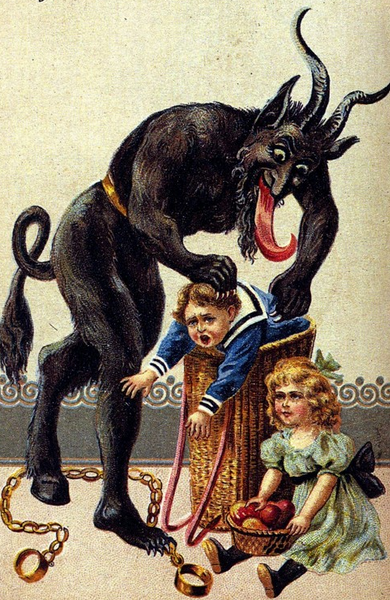Post by DSkillz on Aug 18, 2016 7:10:54 GMT

Krampus
In Austro-Bavarian Alpine folklore, Krampus is a horned, anthropomorphic figure described as "half-goat, half-demon", who, during the Christmas season, punishes children who have misbehaved, in contrast with Saint Nicholas, who rewards the well-behaved with gifts. Regions in Austria feature similar figures and, more widely, Krampus is one of a number of Companions of Saint Nicholas in regions of Europe. The origin of the figure is unclear; some folklorists and anthropologists have postulated a pre-Christian origin for the figure (see Germanic paganism).
In traditional parades and in such events as the Krampuslauf (English: Krampus run), young men dressed as Krampus participate; such events occur annually in most Alpine towns. Krampus is featured on holiday greeting cards called Krampuskarten.
The history of the Krampus figure has been theorized as stretching back to Pre-Christian Alpine traditions. In a brief article discussing the figure, published in 1958, Maurice Bruce wrote:
There seems to be little doubt as to his true identity for, in no other form is the full regalia of the Horned God of the Witches so well preserved. The birch – apart from its phallic significance – may have a connection with the initiation rites of certain witch-covens; rites which entailed binding and scourging as a form of mock-death. The chains could have been introduced in a Christian attempt to 'bind the Devil' but again they could be a remnant of pagan initiation rites.
Discussing his observations while in Irdning, a small town in Styria in 1975, anthropologist John J. Honigmann wrote that:
The Saint Nicholas festival we are describing incorporates cultural elements widely distributed in Europe, in some cases going back to pre-Christian times. Nicholas himself became popular in Germany around the eleventh century. The feast dedicated to this patron of children is only one winter occasion in which children are the objects of special attention, others being Martinmas, the Feast of the Holy Innocents, and New Year's Day. Masked devils acting boisterously and making nuisances of themselves are known in Germany since at least the sixteenth century while animal masked devils combining dreadful-comic (schauriglustig) antics appeared in Medieval church plays. A large literature, much of it by European folklorists, bears on these subjects. ... Austrians in the community we studied are quite aware of "heathen" elements being blended with Christian elements in the Saint Nicholas customs and in other traditional winter ceremonies. They believe Krampus derives from a pagan supernatural who was assimilated to the Christian devil.
Links:
Wikipedia
National Geographic
Krampus.com
Record:
W:
L:
In traditional parades and in such events as the Krampuslauf (English: Krampus run), young men dressed as Krampus participate; such events occur annually in most Alpine towns. Krampus is featured on holiday greeting cards called Krampuskarten.
The history of the Krampus figure has been theorized as stretching back to Pre-Christian Alpine traditions. In a brief article discussing the figure, published in 1958, Maurice Bruce wrote:
There seems to be little doubt as to his true identity for, in no other form is the full regalia of the Horned God of the Witches so well preserved. The birch – apart from its phallic significance – may have a connection with the initiation rites of certain witch-covens; rites which entailed binding and scourging as a form of mock-death. The chains could have been introduced in a Christian attempt to 'bind the Devil' but again they could be a remnant of pagan initiation rites.
Discussing his observations while in Irdning, a small town in Styria in 1975, anthropologist John J. Honigmann wrote that:
The Saint Nicholas festival we are describing incorporates cultural elements widely distributed in Europe, in some cases going back to pre-Christian times. Nicholas himself became popular in Germany around the eleventh century. The feast dedicated to this patron of children is only one winter occasion in which children are the objects of special attention, others being Martinmas, the Feast of the Holy Innocents, and New Year's Day. Masked devils acting boisterously and making nuisances of themselves are known in Germany since at least the sixteenth century while animal masked devils combining dreadful-comic (schauriglustig) antics appeared in Medieval church plays. A large literature, much of it by European folklorists, bears on these subjects. ... Austrians in the community we studied are quite aware of "heathen" elements being blended with Christian elements in the Saint Nicholas customs and in other traditional winter ceremonies. They believe Krampus derives from a pagan supernatural who was assimilated to the Christian devil.
Links:
Wikipedia
National Geographic
Krampus.com
Record:
W:
L:

